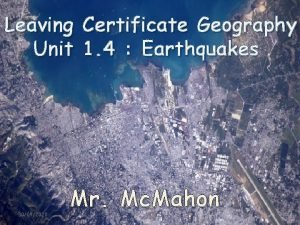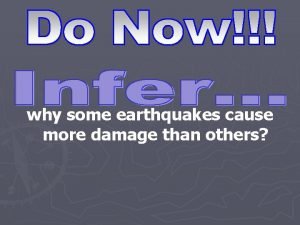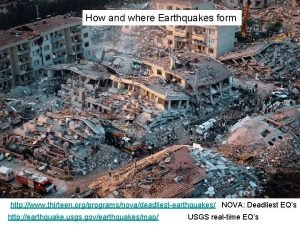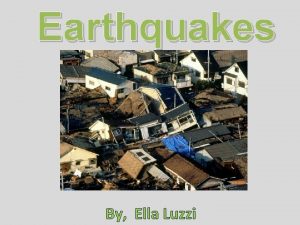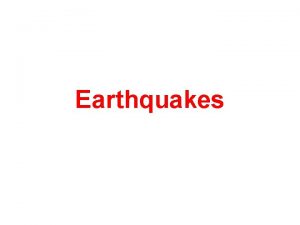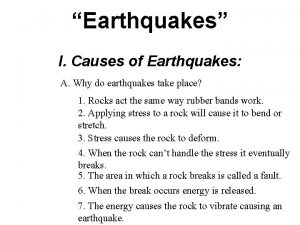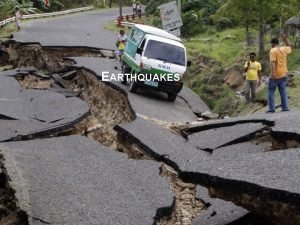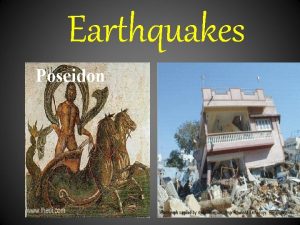Earthquakes I Causes of Earthquakes A Why do









- Slides: 9

“Earthquakes” • I. Causes of Earthquakes: A. Why do earthquakes take place? 1. Rocks act the same way rubber bands work. 2. Applying stress to a rock will cause it to bend or stretch. 3. Stress causes the rock to deform. 4. When the rock can’t handle the stress it eventually breaks. 5. The area in which a rock breaks is called a fault. 6. When the break occurs energy is released. 7. The energy causes the rock to vibrate causing an earthquake.

B. There are three factors that cause breakage in rock. Force that squeezes rock layers together. 2. Tension - Force that stretches rock layers apart. 3. Shear - Force that causes the rock layers to slide by each other. C. Each one of these forces will cause a different fault. 1. Reverse Faults- Compression forces cause this type of fault 1. Compression - 2. Normal Fault- Tension Forces cause this type of fault. 3. Strike-Slip Faults - Caused by shear forces. A. ) Rocks move sideways past each other. B. ) San Andreas Fault in California is this type.

II. Earthquake Energy: A. When rock breaks, energy is released as a seismic wave. 1. Seismic Wave - Energy wave that moves outward, in every direction, form the center of the earthquake. 2. Epicenter - is the point on the earth’s surface directly above the earthquake center. • III. Types of Seismic Waves: A. There are three types of seismic waves. 1. Primary Waves (P waves) - Energy waves that move through the ground in a back and forth motion.

Examples of P waves: A. ) Pushing down on your car and then letting go. B. ) A slinky. * P waves are the fastest moving earthquake waves. (6 km/s). 2. Secondary Waves (S Waves) - Move through the ground in an up and down motion. Examples: A. ) teeter- totter, or seesaw. * S waves move half as fast as P waves. (3 km/s)

Seismic Waves Cont. 3. Surface Waves (L Waves) - Energy waves that travel along the surface of the earth like waves do in the ocean. (Rolling motion) * L waves move the slowest. (1 km/s) * Cause the most damage during an earthquake. • IV. Using Seismic Wave: A. Scientists use the different speeds of seismic waves to find the epicenter of an earthquake. 1. Seismograph Stations - Place where the epicenter Of an earthquake is measured. 2. When an earthquake occurs P waves will reach the seismograph station before the S waves.

Using seismic waves cont. 3. The further the epicenter, the higher the interval between the P wave and the S wave arrival time. 4. When seismic wave information is obtained by at least three stations, the epicenter of an earthquake can be found. 5. P waves travel 6 km/s and S waves travel 3 km/s. 6. When the waves arrive at the station we can calculate the distance to the epicenter. 7. Scientists at each station draw a circle on a map. 8. The radius of each circle is the distance away the earthquake epicenter was. 9. The place where all three circles cross is the epicenter.

V. Earthquake Strength: A. A seismograph is used to measure the strength of an earthquake. 1. The amount of energy released is the earthquakes magnitude. 2. Magnitude is measured using the Richter Scale. 3. A 1 magnitude earthquake is the weakest and a 10 magnitude is the strongest. 4. There has never been a reading over 9. 0 5. An earthquake that is 1 magnitude higher than another releases 32 times more energy. A. ) How much more energy is released from an 8 mag. earthquake than a 6 mag. earthquake? 32 squared = 1024 times more energy released.

VI. Tsunamis: A. What is a tsunami? 1. Tsunami - An earthquake generated ocean wave. B. How do they form? 1. An earthquake or landslide releases energy. 2. If under the ocean the energy will push against the water, generating a powerful wave. 3. These waves can be from 30 to hundreds of feet high. 4. Most occur in the Pacific Ocean.

VII. Earthquake Safety: A. Preparing for an earthquake: 1. Study the region you live in. 2. If there is an earthquake record in that area, other earthquakes can happen. B. Complete yourself. C. Buildings and Highways: 1. Buildings and highway over passes are being reinforced with alternating layers of steel and rubber. 2. Highways are built with concrete reinforced with steel. 3. Some building foundations are built on rollers that can slide on steel beams a few millimeters to ease stress.
